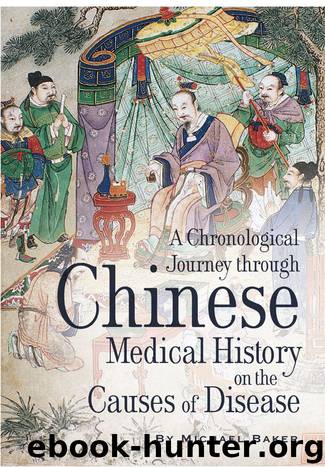A Chronological Journey through Chinese Medical History on the Causes of Disease by Michael Baker

Author:Michael Baker
Language: eng
Format: epub
Publisher: Self Publishing
Figure 11: An illustration of ‘The Bright-lit Hall at Court’ which relates regions of the face to the rest of the body. It describes the movement and character of colours as they change on the face, and the implications for disease.
In his book Ling Shu or T he Spiritual Pivot, Wu Jing-Nuan (2004:141) returns our thoughts to the five sensory organs, leaning on Huang Di’s question that he wished to hear about the five sensory organs to which Qi Bo responded, the sensory organ for the lungs is the nose, for the liver the sensory organ is the eyes, for spleen the sensory organ is the mouth and lips, for the heart the sensory organ is the tongue, for the kidney the sensory organ is the ears.
Wu Jing-Nuan (2004:187) then moves on to learn more of Huang Di’s wish to hear about food and drink, and how the five flavours enter the five viscera, divide and then separate. Qi Bo’s response was that the water and valley Qi entered the stomach to create the sea of the five viscera and six bowels, which in turn all receive their Qi from the stomach. There is a place to which the flavours travel. For example:
• The sour flavour first travels to the liver
• The bitter flavour first travels to the heart
• The sweet flavour first travels to the spleen
• The pungent flavour first travels to the lungs
• The salty flavour first travels to the kidneys
• Finally Wu Jing-Nuan (2004:188) points out the existence of five prohibitions flavours, which are different from the favoured tastes mentioned above. For example:
• When there is disease of the liver pungent foods are prohibited
• When there is disease of the heart salty foods are prohibited
• When there is disease of the spleen sour foods are prohibited
• When there is disease of the kidneys sweet foods are prohibited
• When there is disease of the lungs bitter foods are prohibited
We can see that the influence these prohibitions have on each other follow the Ke cycle, i.e. if we took the last example quoted above, ‘for disease of the lungs, bitter foods are prohibited’, bitter foods are associated with fire which has a controlling influence over the metal whose official is the lungs.
As we consider aspects of five element diagnosis it seems incumbent on us to consider the opinions of [Prof J.R.] Worsley. To provide an access to those opinions I have chosen to use an article written in a Traditional Acupuncture Society Newsletter which took the form of an interview given by [Prof J.R.] Worsley on October 1984.
When asked what he considered to be more important, diagnosis by reading the pulse, or by observing colour, sound, odour, and emotion (C/S/O/E) his response was that neither one is more important than the other. However his experience of teaching many hundreds of practitioners was that in their early days in practice the tendency is for those practitioners to rely on pulse reading; this is something tangible something they can feel, whereas diagnosis via C/S/O/E is more difficult to differentiate.
Download
This site does not store any files on its server. We only index and link to content provided by other sites. Please contact the content providers to delete copyright contents if any and email us, we'll remove relevant links or contents immediately.
Inner Engineering: A Yogi's Guide to Joy by Sadhguru(6259)
The Power of Now: A Guide to Spiritual Enlightenment by Eckhart Tolle(5119)
Fear by Osho(4337)
The Art of Happiness by The Dalai Lama(3649)
Ikigai by Héctor García & Francesc Miralles(3635)
The Ultimate Bodybuilding Cookbook by Kendall Lou Schmidt(3560)
Yoga Therapy by Mark Stephens(3418)
The Little Book of Hygge by Meik Wiking(3300)
Why Buddhism is True by Robert Wright(3144)
The Healing Self by Deepak Chopra(3019)
Being Aware of Being Aware by Rupert Spira(2944)
The Hatha Yoga Pradipika (Translated) by Svatmarama(2883)
Shift into Freedom by Loch Kelly(2880)
Wild Words from Wild Women by Stephens Autumn(2774)
Work Clean by Dan Charnas(2755)
Happiness by Matthieu Ricard(2746)
More Language of Letting Go: 366 New Daily Meditations by Melody Beattie(2681)
Yoga Body & Mind Handbook by Jasmine Tarkeshi(2596)
Why I Am Not a Feminist by Jessa Crispin(2450)
